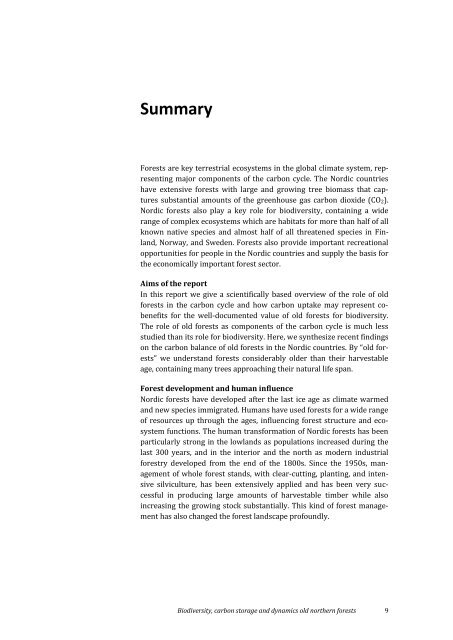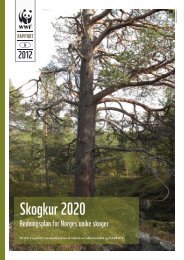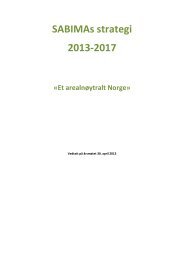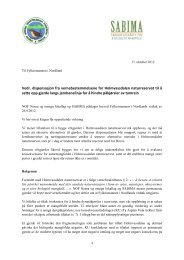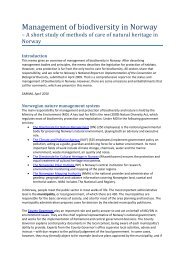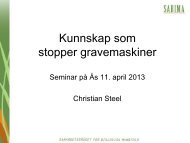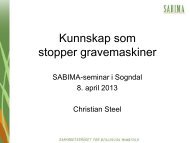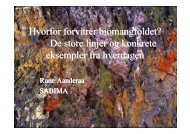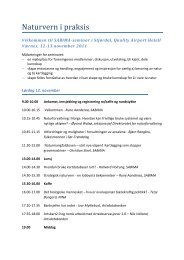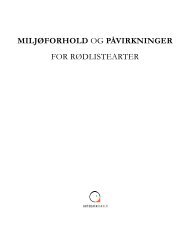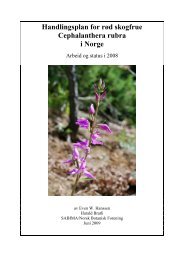Biodiversity, carbon storage and dynamics of old northern ... - BPAN.fi
Biodiversity, carbon storage and dynamics of old northern ... - BPAN.fi
Biodiversity, carbon storage and dynamics of old northern ... - BPAN.fi
You also want an ePaper? Increase the reach of your titles
YUMPU automatically turns print PDFs into web optimized ePapers that Google loves.
Summary<br />
Forests are key terrestrial ecosystems in the global climate system, representing<br />
major components <strong>of</strong> the <strong>carbon</strong> cycle. The Nordic countries<br />
have extensive forests with large <strong>and</strong> growing tree biomass that captures<br />
substantial amounts <strong>of</strong> the greenhouse gas <strong>carbon</strong> dioxide (CO 2).<br />
Nordic forests also play a key role for biodiversity, containing a wide<br />
range <strong>of</strong> complex ecosystems which are habitats for more than half <strong>of</strong> all<br />
known native species <strong>and</strong> almost half <strong>of</strong> all threatened species in Finl<strong>and</strong>,<br />
Norway, <strong>and</strong> Sweden. Forests also provide important recreational<br />
opportunities for people in the Nordic countries <strong>and</strong> supply the basis for<br />
the economically important forest sector.<br />
Aims <strong>of</strong> the report<br />
In this report we give a scienti<strong>fi</strong>cally based overview <strong>of</strong> the role <strong>of</strong> <strong>old</strong><br />
forests in the <strong>carbon</strong> cycle <strong>and</strong> how <strong>carbon</strong> uptake may represent cobene<strong>fi</strong>ts<br />
for the well-documented value <strong>of</strong> <strong>old</strong> forests for biodiversity.<br />
The role <strong>of</strong> <strong>old</strong> forests as components <strong>of</strong> the <strong>carbon</strong> cycle is much less<br />
studied than its role for biodiversity. Here, we synthesize recent <strong>fi</strong>ndings<br />
on the <strong>carbon</strong> balance <strong>of</strong> <strong>old</strong> forests in the Nordic countries. By “<strong>old</strong> forests”<br />
we underst<strong>and</strong> forests considerably <strong>old</strong>er than their harvestable<br />
age, containing many trees approaching their natural life span.<br />
Forest development <strong>and</strong> human influence<br />
Nordic forests have developed after the last ice age as climate warmed<br />
<strong>and</strong> new species immigrated. Humans have used forests for a wide range<br />
<strong>of</strong> resources up through the ages, influencing forest structure <strong>and</strong> ecosystem<br />
functions. The human transformation <strong>of</strong> Nordic forests has been<br />
particularly strong in the lowl<strong>and</strong>s as populations increased during the<br />
last 300 years, <strong>and</strong> in the interior <strong>and</strong> the north as modern industrial<br />
forestry developed from the end <strong>of</strong> the 1800s. Since the 1950s, management<br />
<strong>of</strong> whole forest st<strong>and</strong>s, with clear-cutting, planting, <strong>and</strong> intensive<br />
silviculture, has been extensively applied <strong>and</strong> has been very successful<br />
in producing large amounts <strong>of</strong> harvestable timber while also<br />
increasing the growing stock substantially. This kind <strong>of</strong> forest management<br />
has also changed the forest l<strong>and</strong>scape pr<strong>of</strong>oundly.<br />
<strong>Biodiversity</strong>, <strong>carbon</strong> <strong>storage</strong> <strong>and</strong> <strong>dynamics</strong> <strong>old</strong> <strong>northern</strong> forests 9


